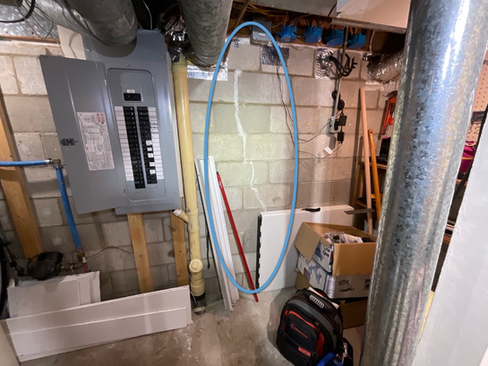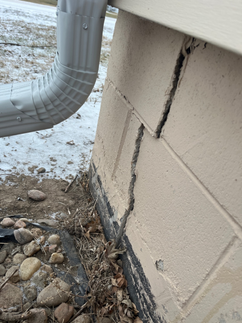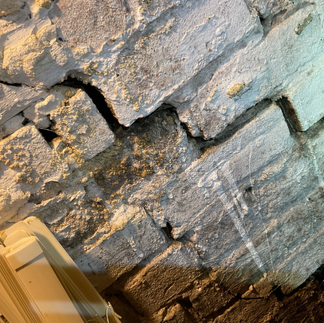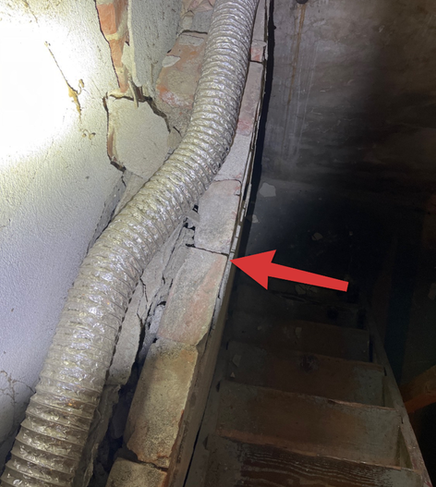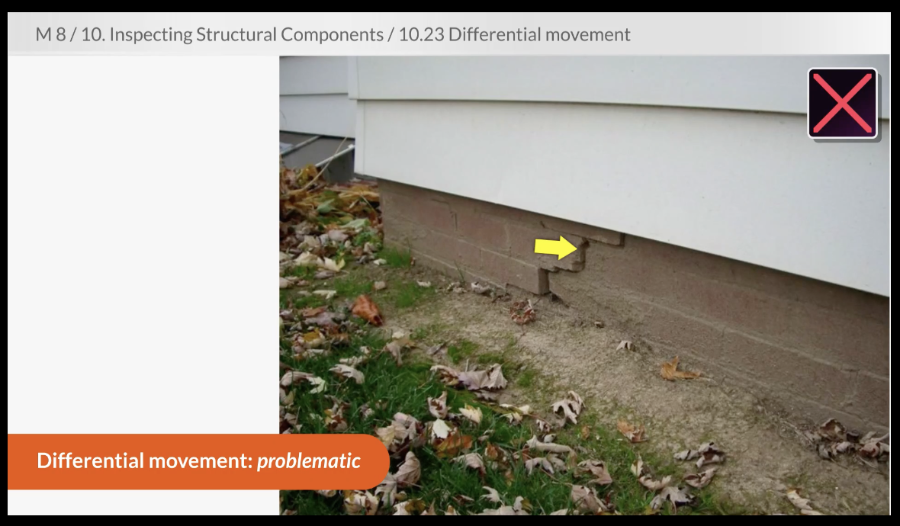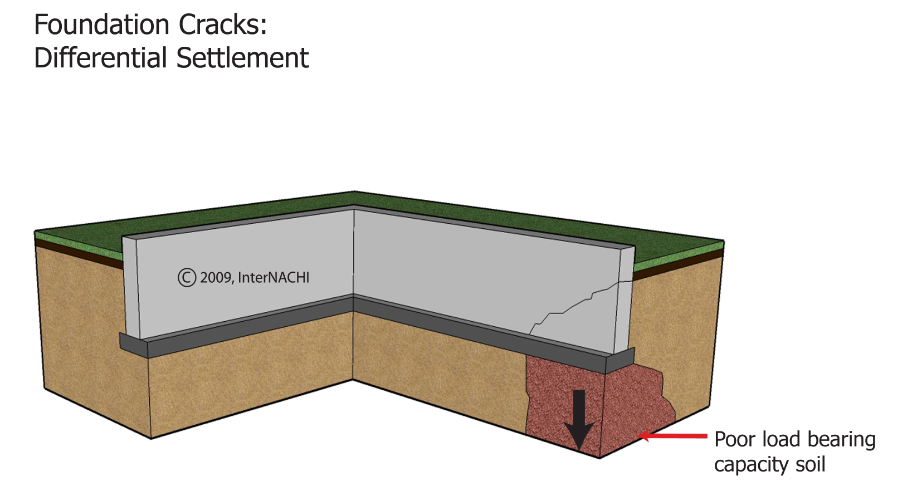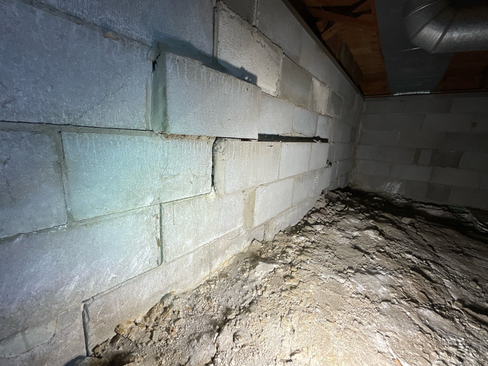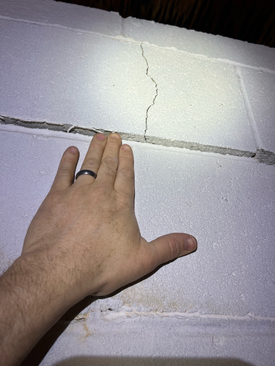Identifying Types of Foundation Cracks
- CNHInspections

- May 18
- 7 min read
Updated: May 25
From a Home Inspection Perspective
CNHInspections is an independent, third-party inspection company committed to providing objective information for homebuyers. Our inspections are conducted solely with the buyer’s best interests in mind. While foundation contractors may offer repair quotes for various types of cracks, our role is not to sell services — it’s to provide clear, unbiased evaluations based on what we observe. We do not represent any outside parties; our only priority is helping our clients make informed decisions with confidence.
Foundation cracks can be unsettling for homebuyers — but not all cracks are serious. This blog shares insights from CNHInspections, using real examples to help you recognize the difference between common settlement cracks and those that may require further evaluation.
The reality is that even experienced inspectors and engineers cannot determine whether a crack is active or dormant based on a single visit. Some cracks may be old and stable, while others could indicate ongoing movement. Since all cracks start small, the only way to know for certain is to monitor them over time. That’s why many structural engineers recommend crack monitoring instead of immediate repair. As home inspectors, our role is to identify visible cracking, note any signs of structural movement, and help you decide when further evaluation by a foundation specialist is warranted.
FOUNDATION WALL CRACKS - EVALUATION GUIDELINES
Cracks in foundation walls are evaluated based solely on their visible condition at the time of inspection. These observations represent a snapshot in time and cannot predict future movement or damage.
Cracking is categorized as follows:
Minor: Crack width ≤ 1/8", minimal or no lateral displacement, and little to no tapering.
Borderline (Moderate): Crack width > 1/8", some lateral displacement, and/or tapering present.
Outside Normal Tolerances (Severe): Crack width ≥ 1/4", visible lateral displacement, and/or characteristics typically requiring repair or stabilization.
In general, cracks 1/4" wide or greater may warrant evaluation by a qualified foundation contractor. Because structural conditions can change over time due to factors like soil movement or weather, home inspectors cannot predict future performance or guarantee the stability of the structure.
COMMON CAUSES OF FOUNDATION WALL CRACKING & MOVEMENT
Foundation cracks and movement can result from a variety of soil and site conditions, including:
Poor Soil Compaction: Inadequate compaction beneath footings can lead to soil consolidation and uneven settling.
Soil Shrinkage: Loss of moisture, often from nearby trees or large vegetation, can cause soil to shrink away from the foundation.
Inadequate Footings: Undersized or improperly constructed footings may fail to support structural loads evenly.
Expansive Soils: Clay-rich soils expand and contract with moisture changes, exerting pressure on foundation walls.
Frost Heave and Root Growth: Freezing soil or aggressive root systems can displace soil and stress the foundation.
Hydrostatic Pressure: Saturated soil increases lateral pressure on the foundation, which can lead to cracking and water intrusion.
Soil Creep: The slow, downhill movement of clay soils on sloped lots can cause foundation stress.
Fluctuating Water Tables: Changes in groundwater levels can destabilize soil beneath the structure.
Soil Erosion: Poor drainage, leaking water lines, or ineffective surface runoff can wash away supporting soil around footings.
Inspection Approach
At CNHInspections, we begin by evaluating exterior conditions that may impact the interior foundation. Since improper water management is a leading cause of foundation problems, we assess grading, gutter performance, downspout placement, surface drainage, and evidence of ponding near the home.
For more on grading best practices and the consequences of poor water control, see CNHInspections' blog: “Grading, Grading... Grading!”
Click to enlarge:
EXPANSIVE SOILS
Before we get into the types of foundation cracks, lets touch base on expansive soils. Expansive soils are clay-based, fine-particle soils that swell when saturated and shrink as they dry. This constant expansion and contraction places stress on foundation walls and can lead to cracking or structural movement — especially in areas with poor grading.

These soils are common throughout the Midwest, and according to the International Association of Certified Home Inspectors (InterNACHI), cause more annual property damage in the U.S. than hurricanes, floods, earthquakes, and tornadoes combined.
Negative or neutral grading around a home exacerbates the effects by allowing water to pool near the foundation. To help prevent damage, mitigation typically includes regrading the surrounding soil to promote proper drainage and/or installing a plastic moisture barrier beneath the topsoil to limit water infiltration near the foundation.
Let's delve into types of cracking and what they may be indicating!
SHRINKAGE CRACKS
Shrinkage cracks commonly appear within the first year of construction and are caused by the natural curing process of concrete. As moisture evaporates from the surface more quickly than from the inner layers, differential drying creates tensile stresses. These stresses are often relieved by the formation of cracks near the surface.
These cracks typically occur in the middle third of the wall and may range from just a few inches in length to extending the full height of the wall — from top to bottom. Importantly, shrinkage cracks generally do not affect the footing or structural integrity of the foundation.
The standard recommendation is to monitor these cracks over time. If they begin to widen or show signs of water intrusion, they should be properly sealed to help prevent moisture entry into the home.
Click to enlarge:
VERTICAL & DIAGONAL CRACKING
Vertical and diagonal cracks are often the result of normal concrete shrinkage or minor foundation settlement, particularly within the first few years after construction. When these cracks are less than 1/4" wide, show little to no lateral displacement, and have minimal tapering, they are generally considered cosmetic and not structurally significant.


Photos from our past inspections, illustrating typical vertical & diagonal cracking. Click to enlarge:
Monitoring is advised to detect any changes. A crack monitor is a low-cost, proactive tool that helps track movement over time. If cracks show signs of widening, shifting, or increased displacement, evaluation by a qualified foundation specialist is recommended.
If water intrusion is observed, professional sealing — such as epoxy injection — is typically advised to protect against moisture damage.
Example of a crack monitor and seepage correction:
NOT ALL VERTICAL CRACKS, HOWEVER, ARE TYPICAL!
Large or expanding cracks, especially those that widen from a specific point of origin, may indicate active movement or structural stress and should be promptly evaluated by a foundation contractor.
A series of vertical cracks next to each other is characteristic of structural cracking. Though some cracks may be within acceptable tolerances it's the culmination of several cracks that warrants an evaluation by a foundation contractor.


A crack that forms a V-shape may indicate heaving from the ground under the foundation footing, but can also be caused by settling toward one corner. In the following illustration photo, the ground beneath the footing is expanding and pushing upward on the footing, causing the crack. This is a major structural concern and warrants repairs.
Moderate to severe vertical cracks:
STAIR-STEP CRACKING
Stair-step cracks appear in the mortar joints of brick or block walls, typically following a stepped pattern. These cracks form at the weakest point—usually the mortar—but may also pass through bricks or blocks if they are weaker than the mortar.
Common causes include differential settlement, uneven stress, or moisture intrusion (often near windows).
If no significant displacement, separation, or gapping is observed, the cracking is generally considered minor. However, weather changes and soil conditions can cause future movement.
Repairing the mortar joint and monitoring for changes is recommended to determine if the cracking remains stable or becomes active.
Minor stair step cracking, click to enlarge:
If the crack size is large, has lateral displacement and/or irregular gapping associated with it, then further evaluation by a foundation contractor is recommended.
Moderate to severe stair step cracking, click to enlarge:
HORIZONTAL
Horizontal cracks typically indicate lateral pressure against the foundation wall and are considered structural concerns. These cracks suggest the wall is bending or bowing inward, compromising its ability to support the structure above. Common causes include poor drainage, improper backfilling, expansive clay soils, frost heave, tree root intrusion, or a high water table.
Unlike vertical or diagonal cracks caused by settlement, horizontal cracks are often accompanied by lateral displacement or bowing. Over time, this can progress and lead to wall failure if not addressed. The most common contributing factor is poorly managed surface water—such as negative grading, absent gutters, or driveways sloped toward the home—leading to hydrostatic pressure against the wall. Saturated clay soils can exert tremendous force, sometimes exceeding 60 pounds per cubic foot, which can push unreinforced concrete block walls inward.
Click to enlarge:
Horizontal crack severity is typically categorized as follows:
Minor: Less than 1/4" wide, minimal lateral displacement, and wall bowing < 3/4". Monitoring with crack gauges is often recommended.
Borderline: Cracks approaching 1/4" wide or bowing near or at 3/4". These may or may not require stabilization, but should be further evaluated by a foundation contractor.
Outside Normal Tolerances: Cracks ≥ 1/4" wide with bowing greater than 3/4" should be evaluated and repaired. Common repair methods include carbon fiber straps, wall anchors, or steel I-beams.
Minor horizontal cracking/bowing, click to enlarge:
Borderline to severe horizontal cracking/bowing, click to enlarge:
Proper water management is critical to preventing further deterioration. Corrective actions may include regrading the soil, installing or upgrading gutter systems, and sealing or reinforcing affected walls.
Example of wall anchors from a past inspection:

DIFFERENTIAL SETTLEMENT
Some degree of settlement is normal in residential structures; ideally, it occurs uniformly across the entire foundation. However, when parts of a building settle at different rates, differential settlement occurs — a structural concern that can lead to cracking, displacement, and compromised load-bearing components.
Differential settlement refers to vertical or horizontal sections of a foundation moving independently of one another. It is commonly caused by poor soil bearing capacity, expansive or inconsistent soil types, or variations in moisture content beneath the foundation.
In the Midwest, many homes are built on clay-rich soils. Because full removal and replacement of expansive clay is typically impractical, builders work with native soil conditions. As clay soils expand when wet and shrink when dry, they can exert pressure on footings and cause uneven movement. Though footings are not visible during a standard inspection, they play a critical role in maintaining the structural integrity of the home.
Evaluation by a qualified foundation contractor is recommended when differential settlement is observed.
The following photos from CNHInspections’ past inspections indicate differential settlement:
According to the InterNACHI Standards of Practice, a home inspector’s role is not to diagnose the exact cause of a foundation crack or prescribe repairs. Instead, the inspection helps determine whether a crack is an immediate concern that warrants evaluation by a qualified foundation contractor or whether it can simply be monitored over time.
Evaluating the home as a whole provides important context. Interior signs of movement—such as sloped floors, cracked drywall, or misaligned doors—may correlate with foundation cracks observed. A thorough inspection by CNHInspections helps buyers make informed decisions, offering clarity and professional referrals when further evaluation is needed during the contingency period.
We hope the information, examples, and illustrations provided in this blog help both homebuyers and real estate agents better understand what to look for when evaluating foundation concerns. Until next time!...








































